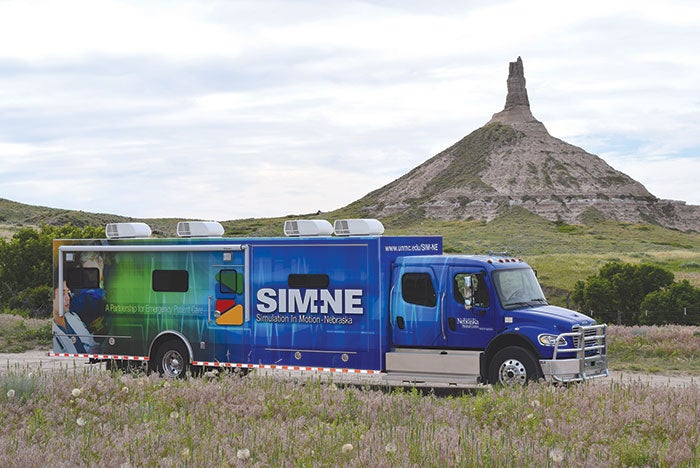Mobile simulation trucks help bring EMS training home

One of four University of Nebraska Medical Center Simulation in Motion-Nebraska trucks.
If you deliver emergency medical training closer to home, they will come. Not only will they come, but the emergency first responders who volunteer at rural emergency medical service agencies and rural critical access hospitals in Nebraska so far are loving it.
That has been the experience of the University of Nebraska Medical Center (UNMC) after it launched a program that sends four customized Simulation in Motion–Nebraska (SIM-NE) trucks to provide free emergency medical training.
The 44-foot-long trucks are fitted with the latest medical equipment and supplies commonly used in emergencies. Each truck includes a simulated emergency room (ER) and ambulance and five computerized mannequins that talk, breathe and respond to treatment.
The volunteer emergency staff use real medical and rescue equipment, including airway-management equipment, cardiac monitors and defibrillators, intravenous supplies, resuscitation equipment, stretchers and more.

Each SIM-NE truck includes video and audio equipment to record the training sessions.
Each truck also includes video and audio equipment to record the training sessions, says Paul Paulman, M.D., assistant dean for clinical skills and quality at UNMC. He was instrumental in obtaining the grant funding used to purchase and equip the trucks at about $1 million each.
North Dakota and South Dakota were early adopters of launching their own program with mobile simulation trucks for training, and Nebraska joined after grant money became available.
Bringing the trucks to their communities for a day of training eliminates the burden of emergency medical services (EMS) volunteers traveling sometimes hundreds of miles to conferences for training and education. Most, if not all, of the volunteers who are state certified for the positions have day jobs.
In the first six weeks of operation, the trucks had traveled to nearly half of Nebraska’s 93 counties, Paulman says. In addition to the EMS staff, the trucks provide training for ER nurses and are sometimes opened to local high school students to encourage them to join the EMS field.




